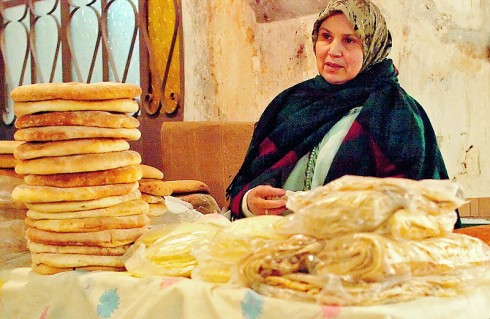
The Migrating Kitchen – Cuisine Takeaways.
Winding down after what seemed to have been a long day, I am amazed at how it always seems like I will derive no greater joy than checking off one more thing on my to-do list before calling it a night – Look up a recipe for Chapman that I had come across the Kitchen Butterfly site some years back. Well, I never made it that far because of the preceding images, a mouth-watering pastiche of different shades of red, orange, yellow and greens. It turned out to be a dish with plantains and peppercorns known as Imoyo but what in fact grab..
what am I saying! not grabbed!..”what sucked all my attention” was this;
“Imoyo dishes are a fusion of West African and Brazilian cuisine. They arose as a result of the Portuguese slave trade which, during the 15th Century took many West Africans to Brazil. Then, in the 19th Century some freed slaves returned and settled on the coast of Nigeria, bringing with them green bell peppers, olive oil and garlic, which were added as a component of Nigerian cuisine.”

Light bulb! Fluorescent bulb! Neon lamps all blazing in my mind – Do you see the connections? I do! Wow!, that makes a lot of sense. For example there is Akara or Acaraje, a Nigerian dish the Brazilians took back to their kitchens. On the flip side, is the Imoyo, a dish, in which a former colony, Nigeria incorporates certain components of Brazilian cuisine into their cooking…
could I stretch the “c”sounding words theme any further – cooking, connections, cuisine? I like the ring to it.
I digress.
Of course! my wheels started spinning and sure enough, I was soon on my jolly way to exploring the possibilities, other connections. Did I get a 2-for-1 deal, a lesson in the history and geography of the different people. Sure did. We have Mozambique, a former colony of Portugal; with a Mozambican dinner, the menu and food are from Mozambique but the service and wines are strictly Portuguese.
In Morocco, “there is the pigeon pie, bastila or bastal, comes from the Spanish word for pastry, pastilla, after the transformation of the phoneme “p” into “b” that is specific to the Arabic language. D. Francisco Javier Simonet’s Glossary of Iberian and Latin words used by the Mozarabs tells us that bestila [sic] is the Mozarab pastel from the Latin

pastillum, a diminuitive of panis, “bread.”This Mozarab bestila becomes the dialectal Moroccan Arabic besthila [sic], also meaning “pastel.”(Source:Cliffwoodawright.com).
Asia too? Yess!!! but not necessarily in the way you may think, West vs. East or vice versa. How? you ask. Now, that I have your attention, Want a taste? sample some of those rich connections offered in a mini-series article, Food Connections by Idea Mani and Makan by the Marocharim Experiment
…Pardon me, I have been running my mouth a mile a minute and done most of the talking so far. I just had to get it all out before I missed anything in all my excitement. Ok! (deep breath in, out and slight pause)…Now, what’s your story? Experienced or know of any other “cuisine connections”? , do share!
All recipes are welcome.

Will definitely try the plantain imoyo salad. I love, love……did I say LOVE….plantain 🙂
When we talk about cuisine connection,one has remember that before 1885 (scramble for Africa), most of the people in Africa lived together and shared the same customs and culture. In 1885, after the Berlin Conference, the continent was partitioned by European powers. People were divided, not by culture but by the new territories carved out of the continent by the Europeans. For example, although the Congo River appears to be a natural geographic boundary, there were groups that otherwise shared a language, culture or other similarity living on both sides. The division of the land between Belgium and France along the river isolated these groups from each other but they still share a similar culture and eat the same food, prepared almost in the same way.
Its really interesting the different food cultures and traditions — Here are a few facts about North African cuisine that relate to your comments and how common borders, interactions or other influences play a role.
In this article about North African cuisine it begins with a Moroccan proverb that says –
“Where there is food, there is no talking.”
“Indeed, as a sign of respect for the food that God has provided and the host or hostess has served, North Africans consider it impolite to converse while eating. The food itself, however, does not remain silent. Food talks. Meals convey messages. Perhaps more than anything else in North African cultural praxis, food habits constitute a rich language through which the region’s history is told, social distinctions are expressed, religious feasts are celebrated, and seasonal changes and transformations in the life cycle are marked.”
It goes on to state that:
“Morocco is the only North African country that was not occupied by the Ottoman Empire during its presence in the region (1500s700s). Correspondingly, dolmas, stuffed vine leaves, like Turkish and Syrian puff pastries such as baklava and brîk, are commonly prepared in formerly Ottoman Algeria and Tunisia, but do not feature in Moroccan cuisine. On the other hand, Algerian, Tunisian and Moroccan cookery alike have been heavily influenced by the introduction of crops from the New World such as tomatoes, courgettes, sweet peppers and potatoes. These foods were introduced to North Africa before they were introduced to central Europe. Potatoes, however, never became as popular in North Africa as they would become in Europe.
Food habits in all three North African countries discussed here have been influenced by French occupation….”
Love, love, love your explorations 🙂 and totally blown away that you got sidetracked from the Chapman post by the Imoyo one. This thrills me to no end…………………
Anyways, I love the idea of Cuisine Connections, like you. Its fascinating to see the multitude of ways in which we’re connected!
Well done :-)!!!!